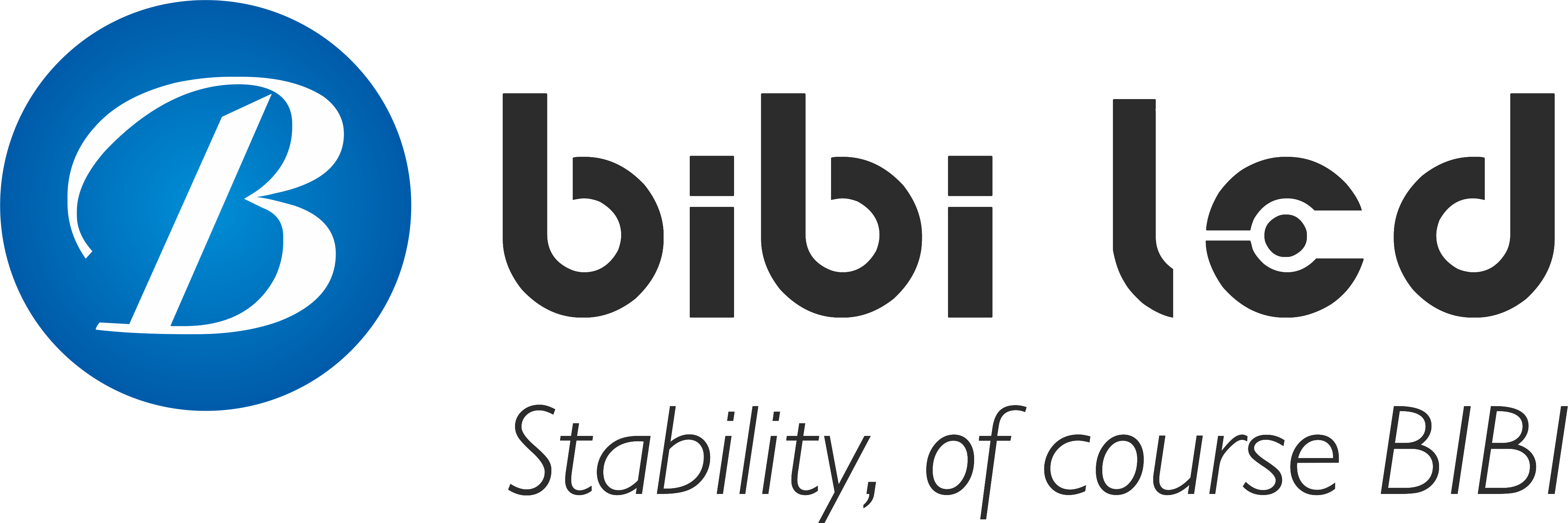Introducción
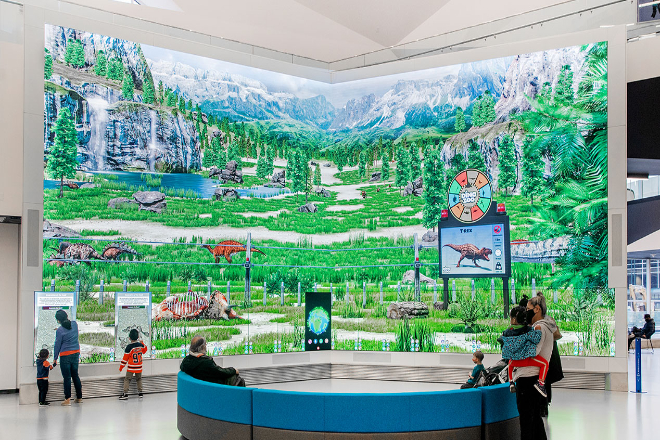
¿Cuánta ganancia puede tener? pantallas de visualización LED ¿Abordar diferentes escenarios? ¿Deberíamos elegir un espacio publicitario exterior concurrido o un centro de conferencias interior?
¿Cómo controlar el coste de la inversión? ¿Cómo maximizar el valor publicitario? Este artículo te los explicará uno por uno para ayudarte a aprovechar al máximo las oportunidades de inversión y maximizar tus beneficios.
Tabla de contenido
1. ¿Cuál es el retorno de la inversión de las pantallas LED?
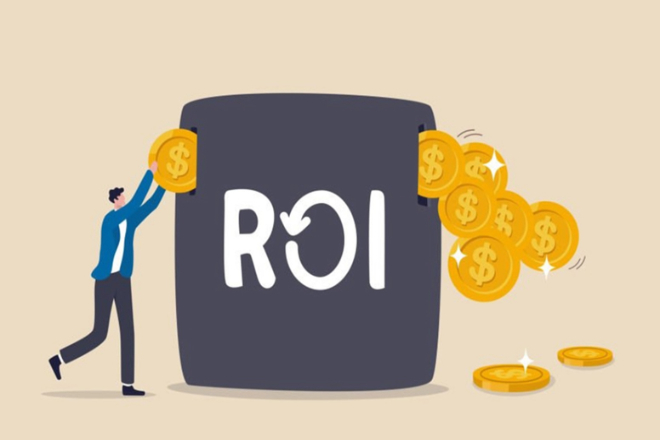
El retorno de la inversión (ROI) es como la relación entre la fruta y la semilla que se cosecha después de plantar una semilla.
En términos simples, es la relación entre el dinero que inviertes y el dinero que ganas a través de este proyecto.
En términos sencillos, es cuánto dinero gastas y cuánto dinero puedes ganar al final.
Supongamos que compra una pantalla LED y la instala en algún lugar para reproducir anuncios.
- Costo:
El costo incluye el dinero que gasta en la pantalla, su instalación y el mantenimiento diario. Estos costos suman su inversión total.
- Ingreso:
Los ingresos son principalmente el dinero que los anunciantes le pagan porque quieren colocar anuncios en su pantalla.
Si su pantalla está en una buena ubicación y tiene un gran flujo de personas, los anunciantes están dispuestos a pagar más.
- Calcular la tasa de retorno:
Se resta el costo de los ingresos para obtener el ingreso neto.
Luego, divida el ingreso neto entre el costo y multiplíquelo por 100% para obtener el retorno de la inversión (ROI). Cuanto mayor sea este número, más rentable será su inversión.
2. ¿Qué factores afectan el retorno de la inversión de las pantallas LED?
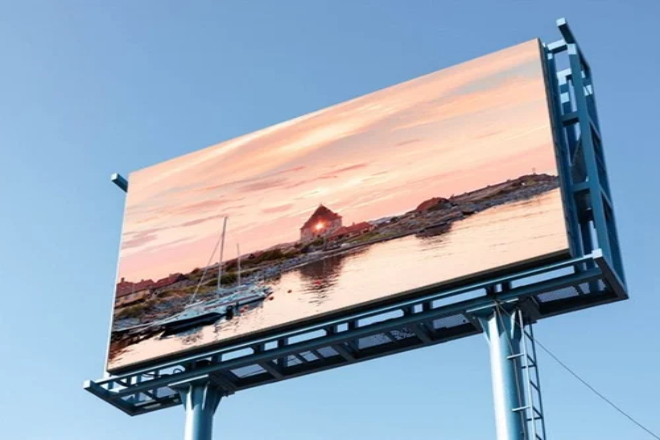
1.1) El dinero para comprar la pantalla
El precio de la pantalla es el factor clave para el retorno de la inversión. El tamaño, la calidad y la marca de la pantalla influirán en el precio.
En términos generales, cuanto más grande sea la pantalla y mejor la calidad de la imagen, mayor será el precio.
Por ejemplo, una pequeña pantalla LED de interior puede ser relativamente barata y adecuada para algunas tiendas pequeñas con presupuestos limitados.
Una pantalla grande de alta definición para exteriores puede ser muy costosa y adecuada para lugares con mucho tráfico para atraer la atención.
La marca también es importante. Aunque las pantallas de las grandes marcas son caras, su calidad está garantizada y son más fiables.
Aunque las pantallas de marcas pequeñas son baratas, pueden tener problemas de calidad y el coste de las reparaciones aumentará más adelante.
1.2) El dinero para instalar
El costo de la instalación de la pantalla también es importante. La ubicación de la instalación influirá en el costo. Si la pantalla se instala en una superficie plana, es relativamente fácil de instalar y el costo es bajo.
Sin embargo, si se instala en la pared exterior de un edificio de gran altura, se requieren equipos y personal profesional, lo que aumenta el costo. La cantidad de trabajo de instalación también es un factor.
Durante la instalación, es necesario construir soportes y tender líneas. Cuanto mayor sea la cantidad de estas obras, mayor será el costo.
Por ejemplo, instalar una pantalla en algunas estructuras de edificios complejas puede requerir más soportes y líneas, y el costo de instalación aumentará.
1.3) Gastos diarios
Los gastos diarios incluyen los costos de mantenimiento y las facturas de electricidad. Estos costos son inevitables durante el uso de la pantalla.
La pantalla se ensuciará después de mucho tiempo y necesitará limpiarse periódicamente.
A veces habrá fallos y reparaciones. Si la pantalla se instala en un lugar polvoriento, la frecuencia de limpieza será mayor y el coste de mantenimiento aumentará.
Las facturas de electricidad también son un factor de coste importante. El consumo energético de la pantalla depende de su tamaño y brillo.
En general, las pantallas grandes y de alto brillo consumen más electricidad. Si la pantalla está encendida las 24 horas del día, la factura de la luz se convertirá en un gasto considerable.
2.1) Valor publicitario
El valor publicitario es un factor clave que influye en los ingresos de las pantallas LED. La ubicación de la pantalla es fundamental.
Si la pantalla se instala en un lugar con mucho tráfico, como una plaza del centro, la entrada de un gran centro comercial o un centro de transporte, la tasa de exposición publicitaria será alta y los anunciantes estarán dispuestos a pagar alquileres más altos.
Por el contrario, si la pantalla se instala en un lugar con menos tráfico, el valor publicitario se reducirá considerablemente. El público objetivo también es importante.
Si la audiencia alrededor de la pantalla es un grupo de alto gasto o profesionales de una industria específica, los anunciantes se sentirán más valiosos y dispuestos a pagar rentas más altas.
La duración del anuncio también es crucial. Si la pantalla puede reproducir anuncios durante mucho tiempo y con alta frecuencia, los anunciantes podrían estar dispuestos a pagar más.
2.2) Entorno del mercado publicitario
El entorno del mercado publicitario también afectará los ingresos. El grado de competencia en el mercado publicitario afectará la renta.
Si hay muchos espacios publicitarios alrededor, los anunciantes tendrán más opciones y el alquiler puede reducirse.
Por el contrario, si los espacios publicitarios son escasos, los anunciantes podrían estar dispuestos a pagar alquileres más altos. La situación económica también tendrá un impacto en el mercado publicitario.
En épocas de bonanza económica, las empresas disponen de presupuestos publicitarios suficientes y una fuerte demanda publicitaria, por lo que el alquiler de la pantalla de visualización puede aumentar.
Mientras que en tiempos de recesión económica, las empresas pueden recortar los gastos de publicidad, lo que se traduce en una disminución del alquiler.
3.1) Tiempo de uso
El tiempo de uso tiene un impacto directo en la eficiencia y los ingresos de las pantallas LED.
Si la pantalla puede funcionar las 24 horas del día y aprovechar al máximo cada período de tiempo para reproducir anuncios u otros contenidos, su eficiencia y su potencial de ingresos serán mayores.
Por ejemplo, algunos lugares que están abiertos las 24 horas del día, como los grandes Centros comerciales, centros de transporte, etc., sus pantallas LED pueden reproducir anuncios durante todo el día para atraer audiencias en diferentes períodos de tiempo, aumentando así los ingresos.
Si la pantalla solo se utiliza en un período de tiempo específico, como el día o la noche, puede desperdiciarse parte del tiempo de publicidad.
Sin embargo, al planificar racionalmente la reproducción de contenidos en diferentes períodos de tiempo, también se puede mejorar la eficiencia de uso.
3.2) Frecuencia de actualización del contenido
La frecuencia de actualización del contenido también es importante. Actualizar el contenido de la pantalla con frecuencia puede atraer más atención de la audiencia y mejorar la eficacia de la publicidad.
Si el contenido que aparece en la pantalla es obsoleto y único, la audiencia puede perder interés, lo que se traduce en una disminución de la eficacia de la publicidad.
Los anunciantes esperan que sus anuncios puedan actualizarse a tiempo para mantenerlos frescos y atractivos.
Si la pantalla de visualización puede responder rápidamente a las necesidades de actualización de contenido del anunciante, aumentará la satisfacción del anunciante y su voluntad de cooperar, aumentando así los ingresos de la pantalla de visualización.
4.1) Actualización tecnológica
Las actualizaciones tecnológicas afectarán la competitividad de las pantallas LED.
Con el desarrollo continuo de la tecnología de visualización, surgen nuevas tecnologías de visualización como las de mayor resolución, más bajo el consumo de energíaY cada vez aparecen más y más pantallas más delgadas.
Si su tecnología de visualización está al revés, puede estar en desventaja frente a la competencia en el mercado.
Por ejemplo, algunas nuevas pantallas LED tienen mejores efectos de visualización y menor consumo de energía, lo que puede atraer más anunciantes y mejorar así el retorno de la inversión.
La compatibilidad y capacidad de ampliación de la pantalla también son importantes.
Si la pantalla es compatible con múltiples fuentes de señal, admite múltiples formatos de reproducción y se puede actualizar y ampliar fácilmente, como agregar funciones interactivas y vincularse con otros dispositivos, la hará más competitiva, extenderá su vida útil y mejorará su retorno de la inversión.
4.2) Políticas y entorno
Las políticas, regulaciones y el entorno del mercado también tendrán un impacto en el retorno de la inversión de las pantallas LED.
Las políticas y regulaciones gubernamentales sobre la industria publicitaria afectarán el funcionamiento de las pantallas de visualización.
Por ejemplo, algunas regiones pueden imponer restricciones en la configuración de la publicidad exterior, incluido el contenido de la publicidad, la altura del espacio publicitario, el área, etc.
Si la pantalla de visualización no cumple con los requisitos de la política pertinente, puede enfrentar rectificaciones o sanciones, incurrir en mayores costos operativos e incluso afectar su uso normal.
La competencia en el mercado afectará el alquiler y los ingresos de las pantallas LED. Ante la gran competencia local, es necesario atraer anunciantes mejorando la calidad del servicio y optimizando el contenido publicitario.
Además, las oportunidades de cooperación con otras empresas o instituciones también afectarán el retorno de la inversión.
Por ejemplo, cooperar con gobiernos locales, grandes empresas, organizadores de eventos, etc. para realizar actividades promocionales conjuntas puede aumentar la exposición y la fuente de ingresos de la pantalla.
En resumen, al invertir en pantallas LED, debe considerar estos factores de manera integral, tratar de reducir costos y aumentar los ingresos, para así lograr un mayor retorno de la inversión.
3. ¿Cuál es el retorno de la inversión de las pantallas LED en diferentes escenarios?
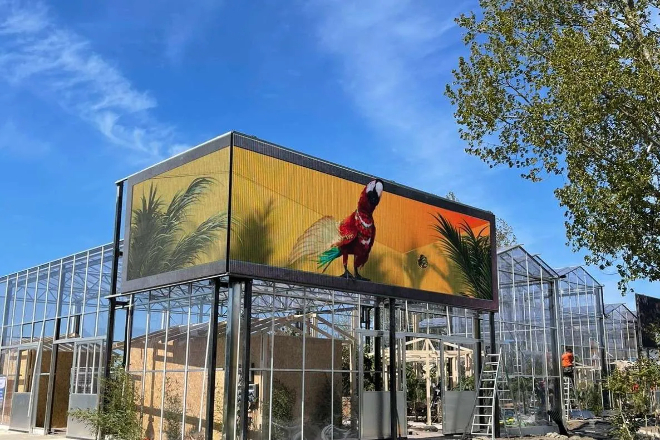
1). publicidad exterior escenario mediático
1.1) Resumen del retorno de la inversión
En los escenarios de medios publicitarios exteriores, el retorno de la inversión de las pantallas LED suele ser bastante alto.
Por ejemplo, usted gasta una suma de dinero para instalar una pantalla grande en la plaza del centro de la ciudad o al costado de la carretera principal para transmitir anuncios.
En general, el capital se puede recuperar en 1 o 2 años y habrá buenos rendimientos cada año a partir de entonces.
Algunas personas han realizado estadísticas y han descubierto que este tipo de pantalla puede aumentar el número de consultas de clientes de los anunciantes en aproximadamente 30%, y las ventas también pueden aumentar en 15%-20%.
1.2) Análisis de factores clave
- Alta tasa de exposición:
Los lugares con mucho tráfico, como las plazas del centro y las entradas de los centros comerciales, tienen mucha gente entrando y saliendo.
Los anuncios en la pantalla pueden ser vistos por más personas, lo que naturalmente atrae clientes y genera ingresos.
- Valor publicitario:
En comparación con las vallas publicitarias tradicionales, las pantallas LED pueden moverse y mostrar varios colores e imágenes, lo que puede atraer más la atención de la gente.
Al igual que las vallas publicitarias electrónicas en las carreteras, pueden atraer la atención de los transeúntes más que los carteles comunes, por lo que los anunciantes están dispuestos a gastar más dinero para alquilarlos.
- Costo de operación:
Aunque cuesta mucho dinero comprar e instalar la pantalla al principio, las pantallas LED ahorran más energía y tienen una vida útil más larga (generalmente varios años), por lo que el costo a largo plazo no es alto.
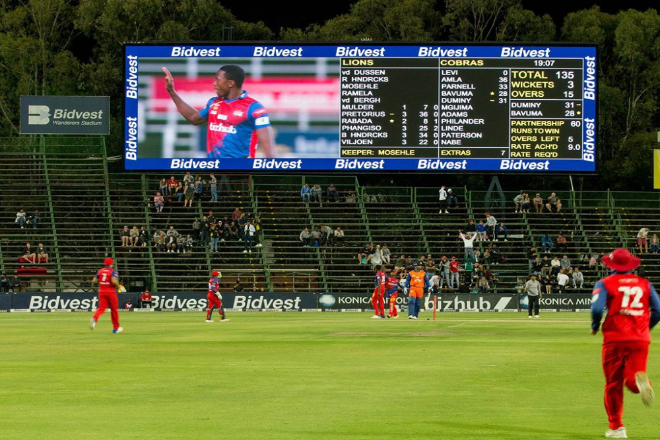
2). Estadio Escena
2.1) Resumen del retorno de la inversión
En los estadios, el retorno de la inversión en pantallas LED también es bastante bueno. Por ejemplo, se invierte en una pantalla en un estadio grande para la transmisión en vivo de partidos, la visualización de información de los atletas y la publicidad.
En términos generales, el costo se puede recuperar en aproximadamente 5 a 8 años, y habrá un retorno de más de 20% cada año a partir de entonces.
Debido a que los eventos deportivos tienen un alto valor publicitario, muchas marcas están dispuestas a gastar dinero para mostrar anuncios durante los juegos.
2.2) Análisis de factores clave
- Alta demanda:
Durante los eventos deportivos, hay muchos espectadores y los anunciantes se apresuran a poner publicidad en las pantallas gigantes de los estadios, por lo que el alquiler también es elevado.
- Requisitos técnicos:
Las pantallas en los estadios deben ser brillantes, la imagen debe ser clara y la frecuencia de actualización debe ser alta, para que la audiencia pueda ver con claridad incluso cuando esté lejos y la luz sea compleja.
- Versatilidad:
La pantalla no solo puede reproducir anuncios, sino también mostrar información del juego y datos de los atletas, e incluso interactuar con la audiencia, lo que aumenta su valor.
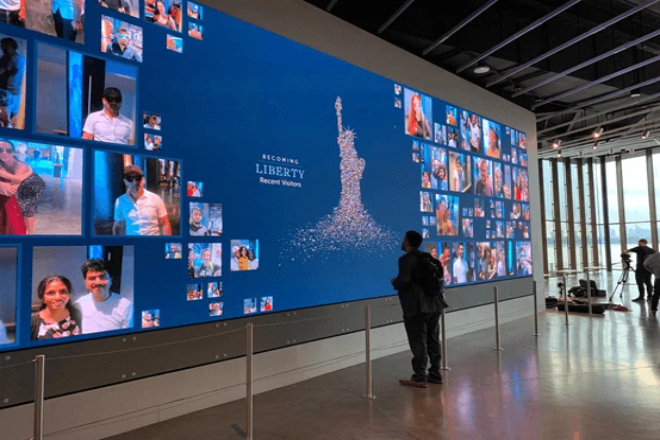
3) Escenarios de conferencias y exposiciones en interiores
3.1) Resumen del ROI
En congresos y exposiciones en interiores, el retorno de la inversión (ROI) de las pantallas LED es relativamente estable. Por ejemplo, se invierte en una pantalla en un centro de conferencias o sala de exposiciones para mostrar productos, reproducir vídeos, etc.
En general, el ROI se sitúa entre 5% y 15%. Si bien no es especialmente alto, es relativamente estable y el riesgo es bajo.
3.2) Análisis de factores clave
- Alto Resolución y reproducción del color:
El ambiente interior es relativamente estable y no es necesario que el brillo de la pantalla sea alto, pero la resolución y el color deben ser buenos para que se pueda mostrar una imagen clara y realista.
- Versatilidad:
La pantalla se puede utilizar no sólo para conferencias y exposiciones, sino también para formaciones corporativas internas, exhibición de productos, etc., lo que aumenta su frecuencia de uso.
- Control de costos operacionales:
Al optimizar la eficiencia del equipo y reducir el consumo de energía, se pueden controlar los costos y mejorar el retorno de la inversión.
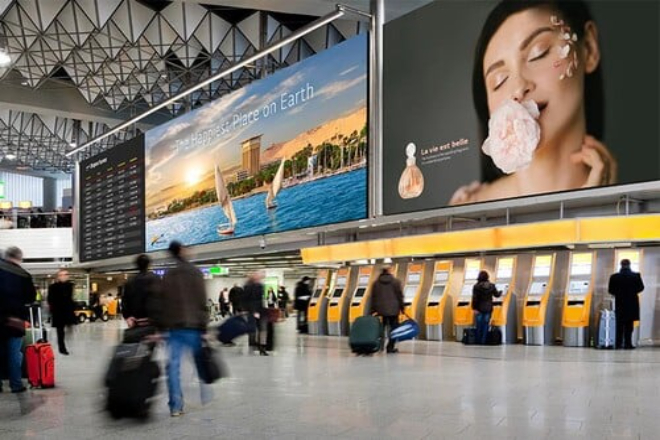
4) Escenarios de centros de transporte
4.1) Resumen del retorno de la inversión
En los centros de transporte, como las estaciones, aeropuertos, muelles, etc., el retorno de la inversión en pantallas LED también es bastante alto.
En general, el costo se recupera en un plazo de 5 a 8 años, y la tasa de retorno anual supera los 20% a partir de entonces. Dado que estos lugares tienen un flujo de personas particularmente alto, el valor publicitario es alto.
4.2) Análisis de factores clave
- Alto flujo de personas:
Los centros de transporte están abarrotados de gente y el valor publicitario es alto. Los anunciantes están dispuestos a gastar mucho dinero en el alquiler de pantallas.
- Demanda de visualización de información:
La pantalla no sólo puede transmitir anuncios, sino también mostrar información sobre trenes, vuelos y barcos, lo que aumenta su valor.
- Requisitos técnicos:
Estas pantallas deben ser brillantes, impermeables y a prueba de polvo porque el entorno exterior es más complicado.
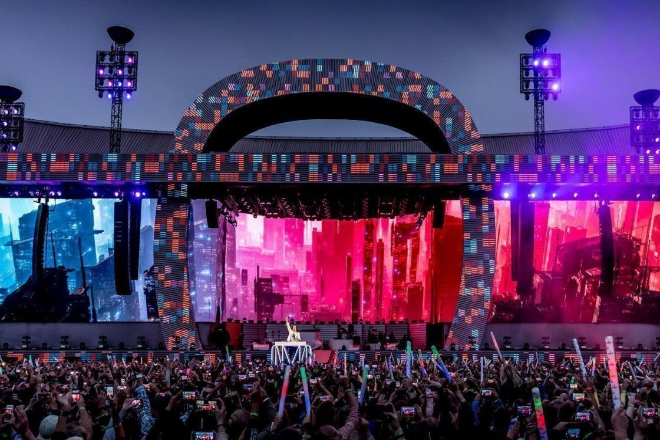
5) Eventos especiales y escenarios de alquiler
5.1) Resumen del ROI
En eventos especiales y alquileres, el retorno de la inversión (ROI) de las pantallas LED es relativamente alto y flexible. Por ejemplo, se invierte en una pantalla para espectáculos, conciertos al aire libre, exposiciones temporales, etc.
En general, el ROI se sitúa entre 5% y 15%, debido a la alta demanda de pantallas en estos eventos y a los altos costos de alquiler.
5.2) Análisis de factores clave
- Alta flexibilidad:
Las pantallas LED se pueden montar y desmontar rápidamente según las necesidades del evento, lo que es adecuado para escenarios de uso temporal y aumenta su frecuencia de uso.
- Alta demanda:
La demanda de pantallas LED en el mercado de eventos especiales y alquiler es fuerte, especialmente durante grandes eventos y actuaciones, cuando los anunciantes y organizadores de eventos están dispuestos a gastar mucho dinero para alquilar pantallas.
- Requisitos técnicos:
Estas pantallas deben ser brillantes, de alto contraste y tener un buen ángulo de visión, para que puedan proporcionar buenos efectos visuales en diferentes entornos.
En general, el ROI de las pantallas LED en diferentes escenarios varía.
En medios de publicidad exterior, estadios y centros de transporte, el retorno de la inversión suele ser alto debido al gran flujo de personas y al alto valor publicitario, y el costo generalmente se puede recuperar en 1 o 2 años.
En congresos y exposiciones en interiores, eventos especiales y alquileres, el retorno de la inversión es relativamente estable, pero también considerable.
A la hora de invertir, puedes elegir la escena adecuada según tu propia situación y necesidades, para que puedas obtener mejor el retorno de la inversión.
4. ¿Cómo puedo obtener un mayor retorno de la inversión?
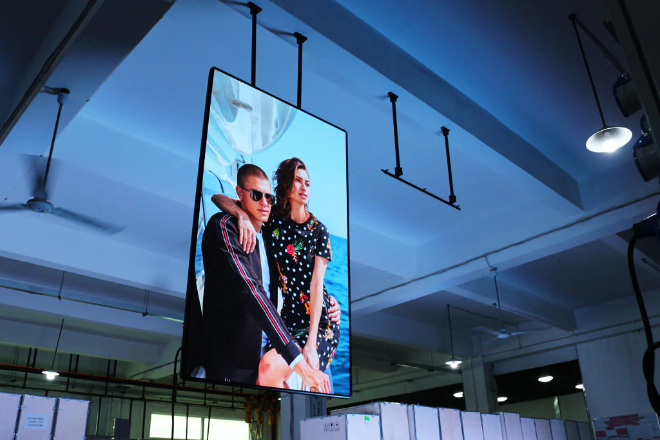
1) Elija la ubicación adecuada
1.1) Panorama de los medios publicitarios exteriores
- Lugares con gran flujo de tráfico:
Instale la pantalla en lugares de mucho tránsito de personas, como plazas del centro, entradas de centros comerciales y calles concurridas.
Cuanto más gente haya, más gente verá el anuncio y los anunciantes estarán dispuestos a pagar alquileres más altos.
- Lugares con transporte conveniente:
Si la pantalla se instala junto a una arteria de tráfico importante, como una salida de autopista o cerca de una estación de metro, los conductores y los transeúntes pueden verla, el efecto publicitario será bueno y el alquiler puede ser más alto.
1.2) Escena del estadio
- Lugares para grandes eventos:
Elija estadios grandes, como lugares que puedan albergar grandes partidos de fútbol y conciertos.
En estos lugares se celebran muchos eventos y hay muchos espectadores, y los anunciantes están dispuestos a pagar mucho dinero para alquilar pantallas.
- Lugares deportivos populares:
Por ejemplo, canchas de baloncesto, canchas de bádminton, etc. Estos lugares suelen tener competiciones y actividades, tráfico estable y un alto valor publicitario.
1.3) Escenarios de conferencias y exposiciones en interiores
- Centros de conferencias de alto nivel:
Elija lugares donde se celebren habitualmente conferencias y actividades empresariales de alto nivel, como salas de conferencias en hoteles de cinco estrellas y grandes centros de exposiciones.
La calidad de los clientes en estos lugares es alta y los anunciantes están dispuestos a pagar precios elevados.
- Salas de exposiciones profesionales:
Por ejemplo, salas de exposiciones de ciencia y tecnología, salas de exposiciones de arte, etc. El público de estos lugares está interesado en campos específicos y los anunciantes pueden colocar anuncios con precisión, con buenos resultados y una alta rentabilidad.
1.4) Escenas de centros de transporte
- Grandes estaciones y aeropuertos:
Los lugares con mucho tráfico, como estaciones de tren, estaciones de autobuses y aeropuertos, tienen un valor publicitario especialmente alto.
Por ejemplo, en la terminal del aeropuerto, los pasajeros tienen tiempo para ver anuncios y los anunciantes están dispuestos a pagar precios altos.
- Estaciones de metro y autobuses:
Las estaciones de metro y de autobuses también son buenas opciones, con mucho tráfico y alta exposición publicitaria.
1.5) Eventos especiales y escenas de alquiler
- Lugares de eventos populares:
Elija lugares donde se celebren habitualmente grandes eventos, como grandes festivales de música, lugares de espectáculos al aire libre, etc.
En estos lugares hay muchas actividades, la demanda de pantallas es fuerte y el alquiler también es elevado.
- Espacios multifuncionales:
Por ejemplo, algunos espacios multifuncionales que pueden albergar bodas, exposiciones y espectáculos tienen una alta frecuencia de uso y un alto retorno de la inversión.
2) Mejorar la eficiencia del uso
2.1) Tiempo de uso
- Uso en todo tipo de clima:
Si es posible, intente mantener la pantalla activa las 24 horas del día. Por ejemplo, en lugares como centros comerciales y estaciones de transporte que abren las 24 horas, la pantalla puede mostrar anuncios todo el día para aumentar los ingresos.
- Acuerdo de contenido de tiempo compartido:
Los diferentes contenidos se organizan según distintos períodos de tiempo.
Por ejemplo, durante el día se reproducen anuncios comerciales y durante la noche información sobre actividades culturales.
Esto puede atraer audiencias en diferentes períodos de tiempo y mejorar la eficiencia del uso.
2.2) Frecuencia de actualización del contenido
- Actualización frecuente de contenido:
Actualice con frecuencia el contenido de la pantalla, como cambiar nuevas imágenes publicitarias y transmitir las últimas noticias.
Esto puede atraer a más espectadores y los anunciantes también sentirán que vale la pena y estarán dispuestos a pagar más.
- Contenido interactivo:
Si es posible, agregue algún contenido interactivo, como permitir a los espectadores votar a través de sus teléfonos móviles y participar en sorteos.
Esto puede aumentar la sensación de participación de la audiencia y mejorar la eficacia de la publicidad.
3) Optimizar el contenido publicitario
3.1) Anuncios atractivos
- Imágenes de alta calidad:
Las imágenes publicitarias deben ser claras y coloridas para captar la atención. Nadie quiere ver imágenes borrosas y tenues.
- Contenido creativo:
El contenido publicitario debe ser creativo, como utilizar animaciones, vídeos, etc., para mostrar los productos, lo cual resulta más atractivo que simples imágenes.
3.2) Entrega de precisión
- Comprender a la audiencia:
Comprender las características de las personas que rodean la pantalla, como los jóvenes, los trabajadores de oficina o los ancianos.
De acuerdo a las características de la audiencia, entregar anuncios que les interesen, para que el efecto publicitario sea mejor.
- Anunciantes colaboradores:
Cooperar con los anunciantes para personalizar el contenido publicitario según sus necesidades, lo que puede mejorar la satisfacción de los anunciantes y aumentar las oportunidades de cooperación.
4) Operación flexible
4.1) Usos múltiples
- Combinación de publicidad y visualización de información:
Las pantallas LED no sólo pueden transmitir anuncios, sino que también pueden mostrar otra información, como información sobre trenes y vuelos en centros de transporte e información sobre juegos en estadios.
Esto puede aumentar el valor de uso de la pantalla y mejorar el retorno de la inversión.
- Alquiler temporal:
Si tienes tiempo libre, puedes alquilar la pantalla a otras actividades o empresas para aumentar tus ingresos.
4.2) Ajuste oportuno
- Cambios en el mercado:
Preste atención a los cambios del mercado y ajuste el contenido publicitario y el alquiler de manera oportuna.
Por ejemplo, cuando la economía va bien, se puede aumentar el alquiler adecuadamente; cuando la economía va mal, se puede reducir el alquiler adecuadamente para atraer más anunciantes.
- Actualizaciones tecnológicas:
Preste atención a las actualizaciones tecnológicas, actualice la pantalla de manera oportuna y mantenga la competitividad.
Por ejemplo, si la nueva tecnología de pantalla es más eficiente energéticamente y tiene mejor calidad de imagen, puede considerar actualizarla, lo que puede atraer más anunciantes.
5. Conclusión
A través del análisis detallado de este artículo, ¿tiene una comprensión más clara del retorno de la inversión de las pantallas LED?
Elegir la ubicación correcta, mejorar la eficiencia del uso, optimizar el contenido publicitario y una operación flexible, estas estrategias le ayudarán a lograr altos rendimientos en diferentes escenarios.
Invertir en pantallas LED no sólo puede traer beneficios considerables, sino también mejorar la influencia de la marca.
Finalmente, si quieres saber más sobre las pantallas LED, Por favor póngase en contacto con nosotros.
